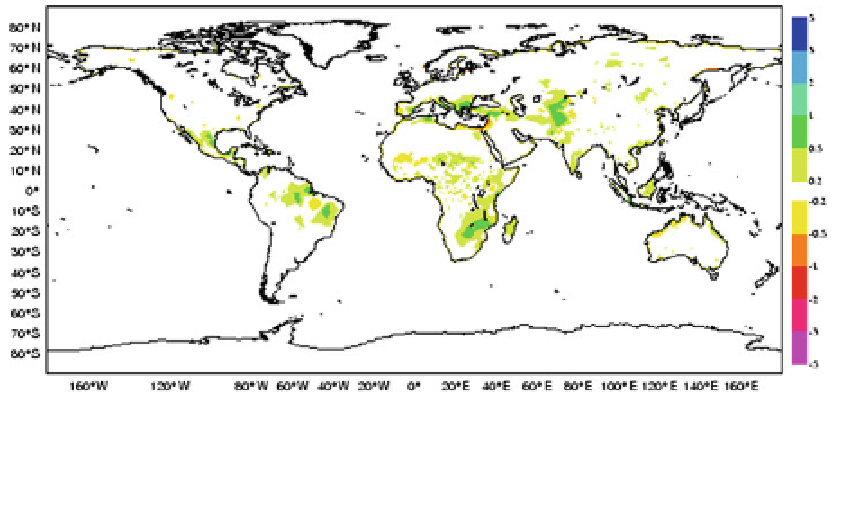Geoscience Reference
In-Depth Information
Fig. 4 Mean difference of monthly mean 36-h forecasts (12 UTC) error in 2-m temperature (in K) between
the OI and the EKF soil moisture analysis schemes for July-August-September. Greenish colours indicate
an improvement of the EKF compared to the OI, while reddish colours indicate a degradation
assimilation improves the model soil moisture and screen-level parameters. However, they
found that compared to the OI soil moisture analysis, ASCAT soil moisture nudging
scheme has a slightly negative impact on the atmospheric forecasts. De Rosnay et al.
(
2012
) evaluated the use of ASCAT soil moisture data in the EKF soil moisture analysis,
showing a neutral impact on both soil moisture and screen-level parameters forecasts. At
the UKMO, Dharssi et al. (
2011
) investigated ASCAT surface soil moisture data assimi-
lation using a simple nudging scheme, as already used at the UKMO to analyse soil
moisture from screen-level parameter information. They showed that assimilating ASCAT
data, in addition to screen-level information in their nudging scheme, improves soil
moisture analysis and forecasts scores of screen-level parameters in the tropics, in Aus-
tralia and in North America. Based on their positive evaluation results, ASCAT soil
moisture nudging was implemented in operations in July 2010 at the UKMO.
The ESA SMOS (Soil Moisture and Ocean Salinity) mission was launched in 2009
(Kerr et al.
2007
). Based on L-band passive microwave measurements, SMOS is the first
mission dedicated to soil moisture remote sensing. The future NASA (National Aero-
nautics and Space Administration) SMAP (Soil Moisture Active and Passive) mission,
planned to be launched in 2015, will be a soil moisture mission that combines active and
passive microwave measurements to provide global soil moisture and freeze/thaw state
(Entekhabi et al.
2010
). ECMWF plays a major role in developing and investigating the use
of new satellite data for soil moisture analysis. SMOS brightness temperature product has
been monitored in near-real time since November 2010, as described in Sabater et al.
(
2011
). Work toward assimilation of SMOS data over land is ongoing.
An extensive evaluation and comparison between SMOS, ASCAT and ECMWF soil
moisture was conducted by Albergel et al. (
2012
), using existing soil moisture networks in
Europe, Africa, Australia and the USA. Using more than 200 stations to evaluate the
remotely sensed and analysed soil moisture products in contrasted climate conditions, the
authors showed that (1) SMOS and ASCAT soil moisture products are of similar quality,
with annual mean correlation 0.53 for ASCAT and 0.54 for SMOS, and (2) the analysed
product is of better quality than the satellite products with 0.70 averaged correlation value.

